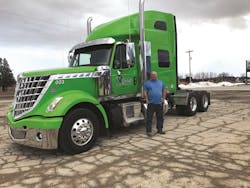Cliff Robertson has been around trucking his entire life, having spent many summers of his childhood riding shotgun with his dad. He’s been driving for 25 years and has been leased to X-Treme Trucking for the last three years. He drives a 2017 International LoneStar with an ISX 475 Cummins and pulls drop-and-hook flatbed, drop-deck and Conestoga trailer freight, both full truckload and LTL, including over-dimensional and general freight. Robertson often handles multi-load jobs when a customer has hundreds of loads moving in the same direction.
Q: What challenges do you face with your maintenance program? How do you resolve each?
A: With the new truck, the biggest challenges are learning the DEF system and the computer and electronics that operate the truck. This is going to be a huge learning curve for someone who has mainly driven and owned older trucks. To resolve this, I’m relying on the instruction manuals, mechanics, and the owner of X-Treme Trucking’s father, who has decades of experience as an OEM shop manager and who now works for his son. [Ed. note: At the time of this interview, Robertson was just making his first run.]
Q: How are maintenance and repairs handled?
A: All of my maintenance and repairs are handled either by the carrier’s mechanics or a single OEM that I’ve used for years where I’m very familiar with the shop manager and the mechanics. I very rarely have any maintenance or repairs done on the road. I’m home most weekends, so this has become fairly routine.
Q: What do you do to ensure CSA compliance for your truck/trailer?
A: Maintenance, maintenance, maintenance followed by inspections (pretrip, post-trip and mid-trip). Inspecting the truck is crucial to staying safe—from the point when you start your driving day, any time you stop, and at the end of the day.
Q: How do you minimize downtime?
A: I constantly inspect and have equipment inspected from pretrip to post-trip, and the OEM and company shop mechanics do regular inspections as well. I have the oil changed every 20,000 mi. (the OEM recommends every 60,000 mi.). Old school lessons are hard to break.
Q: What are your truck’s specifications?
A: [The specs are a] Cummins ISX engine, 13- or 18-speed, 115-gal. tanks, and a wheel base that provides the clearance from the trailer for the headache rack—and a much bigger sleeper. I was tired of living in a 24-in. coffin. My truck-driving dad has always been an International man, so that was the other important specification; it had to be an International.
Q: What do you enjoy most about what you do?
A: I enjoy the challenge. The harder, the bigger, the more challenging the load, the more I enjoy the job. I could never just bump docks and sit in the truck waiting for the truck to be loaded or unloaded. I have to be right in the middle of it, figuring out the safest way to load it, tie it down, and to tarp it so it looks like a piece of art.
We want to hear from you. Know of a trucking business we should feature? Send their contact information to [email protected].
